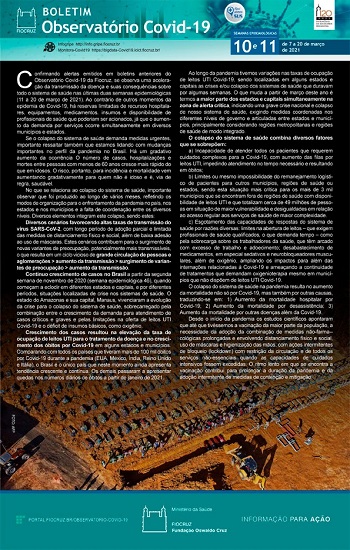Fiocruz Bulletin COVID-19 alerts that pandemic is getting younger in Brazil
01/04/2021
Regina Castro
The Bulletin of the Fiocruz Covid-19 Observatory, released on March 26, shows that the country is facing the collapse of the health system. At the same time, the pandemic is now taking up new shapes, affecting younger age groups: 30 to 39 years old, 40 to 49, and 50 to 59. In such a scenario, researchers defend the adoption of measures in two interconnected groups.
The first group includes urgent measures that involve the containment of the rates of transmission and growth of cases by employing blocking or lockdown measures, accompanied by the increased number of beds with quality and safety, as well as prevention of shortage of drugs and consumables. The second group is comprised of mitigation measures, with the goal of reducing propagation speed. These measures should be arranged at different moments and based on how the disease evolves in the country until 70% of the population is vaccinated.
The new edition alerts to the fact that since the beginning of the pandemic scientific studies have been highlighting the need to vaccinate most of the population while simultaneously adopting prolonged non-pharmacological measures involving physical and social distancing, wearing face masks, washing hands, and intermittent lockdown actions to restrict circulation and limit all non-essential services when intensive care services are overwhelmed.
“The slow rollout of the vaccination campaign is contributing to make the pandemic last longer, resulting in the intermittent adoption of containment and mitigation measures”, emphasize the researchers of the Observatory, in charge of the Bulletin.
The Bulletin points to the fact that the pandemic is gaining a new face in Brazil: it is now rejuvenated. The study shows there has been a significant increase in the rate of Covid-19 cases in the age groups 30-39, 40-49, and 50-59, as attested by the most recent data of SivepGripe on Severe Acute Respiratory Syndromes in Brazil, observed in the first months of 2021. As a consequence, the concentration of cases in more advanced age groups has been falling and shifting to younger ages.
The researchers emphasize that since the beginning of the second wave, on the 46th epidemiological week (between 8 to 14 November 2020), health services have been seeing more young people with symptoms. This increase was higher than what has been observed for other age groups. The investigation draws attention to the shift of incidence rates to the younger age groups and to the maintenance of mortality concentrated on higher age groups. This change is still in its early weeks and has been contributing to the critical scenario regarding the occupation of hospital beds. As this population is less afflicted by comorbidities, therefore having a slower evolution of serious and fatal cases, these patients frequently remain more days in intensive care.
The data presented in the Bulletin show that when the first epidemiological week of 2021 and the 10th epidemiological week (7 to 13 March) are compared, the absolute increase in cases has been 316.88%. However, when the age groups 30-39,40-49 and 50-59 years old are analyzed, researchers observed an increase of 565.08%, 626%, and 525.93% respectively, suggesting a shift to younger age groups. This ratio is less expressive when it comes to deaths: the increase in the same period has been 223.10%. The age group from 30 to 39 years old had an increase of 352.62%. There has been an increase of 419.23% for the age group between 40 and 49 and of 317.08% for the group between 50 and 59. The shift is even less remarkable when it comes to deaths, highlight the researchers.




